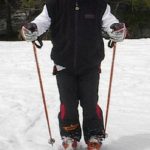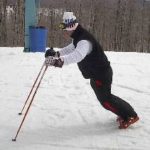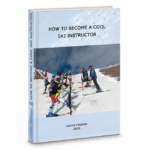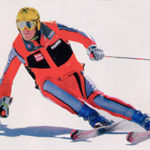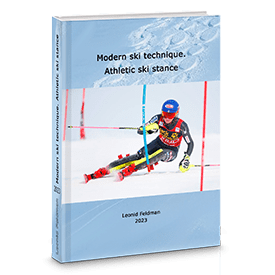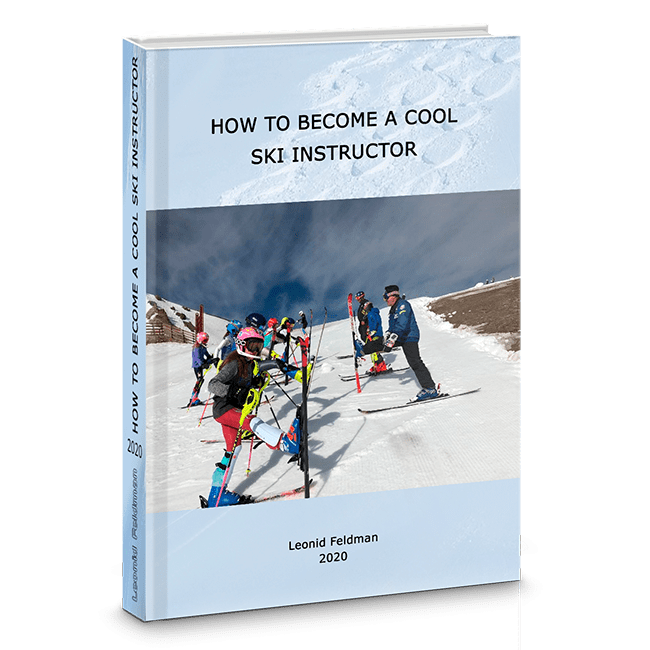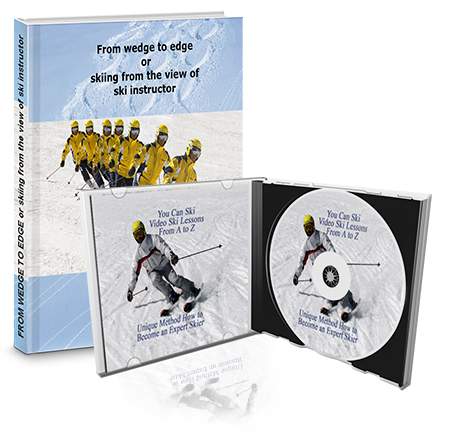Here I would like to share the reasons for training beginners, to note their most typical mistakes and ways to correct those mistakes. I want to make clear that this entire section is devoted to beginners (on the Skill scale – up to the fourth level inclusive). Why stop at this level? Because movements incorrectly carried out at a beginning level, very quickly develop into habits and essentially prevent further perfection of skills. Consistent, habitual mistakes are more frequently the lot of those who have been skiing for many years, not beginners.
Unfortunately, the majority of skilled skiers don’t wish to retrain, although correcting old mistakes and acquiring new skills would certainly do them good. In my opinion, modern skiing techniques are much more elegant and more rational than those of ten years ago. However there are varying opinions on this subject. I believe that most will agree that the basics of skiing techniques have not changed.
It would be wonderful, if every beginner making his/her first steps were supervised by an expert ski instructor! Unfortunately, this is not always the case, so try to follow the advice we give here.
The basis for correct mountain skiing is the balanced stance: Arms – slightly bent at the elbows, in front and slightly apart approximately 20-24 inches. Feet – 10-12 inches apart, knees slightly bent, you feel the pressure on the tongues of your boots. The weight is evenly distributed on the foot, ankles slightly rest against the tongues of boots, and are pointing forward.
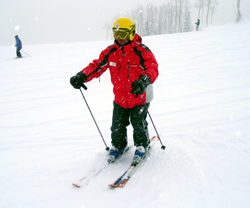
Put into words, this sounds extremely simple, however all these elementary components of beginning-level skiing techniques represent a number of difficulties for the student. What mistakes arise from the very beginning?
“Sitting on the back chair” with legs that are too straight without contact between the ankle and tongue of boot.
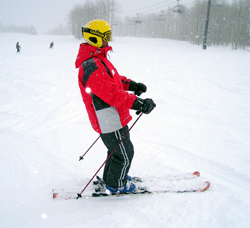
Sitting on the back chair
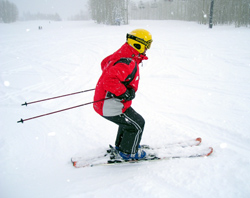
Hands pressed to the body.
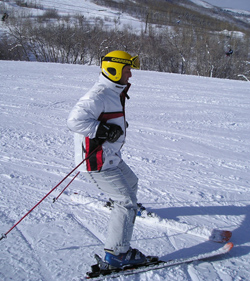
Hands pressed to the body.
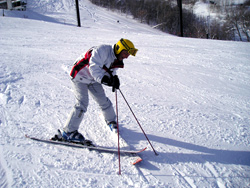
Looking down at your skis.
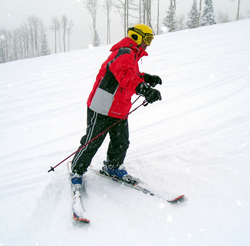
Turning the upper body uphill.
Why are all of these – mistakes? Legs that are too straight and absence of contact between the ankle and tongue of boot leads to loss of control over the front part of the skis, resulting in unguided skis. Hands that are pressed to the body only aggravate the “sitting on the back chair” position and create problems with lateral balance. Looking down causes stress and makes the shoulders and back rigid, limiting the dynamics of movements necessary even for initial-level turns.
To correct these mistakes, I would recommend the following exercise: imagine that there is a heavy object in front of you which you are pushing forward with slightly bent hands. Rest your palms against it, and feel, at the same time, your shins resting against the tongues of boots. As a variant, pretend that you are pushing a closed door that opens out. Go downhill, pushing the door open for 2-3 yards and stop in the wedge position.
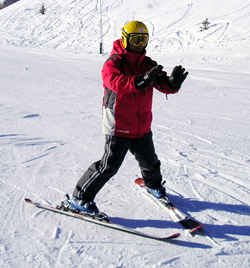
Usually, preparatory exercises, such as sliding on a flat place pushing with poles with one ski on either right or left leg, or steps in a flat place in either direction with skis on both legs, do not cause special difficulties but as soon as the tips of skis in the wedge position are put downhill, problems arise. The first and the most simple – the skier tries to stop by sticking the poles in the snow.
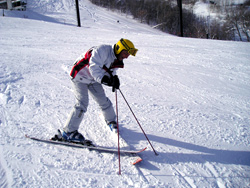
This problem is solved very simply: put away the poles and make sure that your arms are positioned correctly.
A variant to that is to try to learn to stop while traversing a slope. That is directing the skis practically across a slope on a very flat place, trying to lightly press on the downhill ski and bending the downhill knee more.
The most typical mistake is for the tips of the skis to cross (photo 3). As a rule, this means that the skier is balanced behind; in other words he is too far bent backward thus the contact between the ankle and tongue of a boot is, naturally, lost. Try not to hurry and to analyze the stance closely.
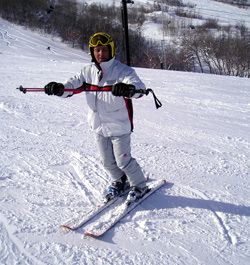
Especially important is what I already mentioned above – you should always feel the pressure of the shins upon the tongues of your boots with arms slightly bent, extended forward and away from your body. Here is a rather useful exercise – take two poles and hold them across the upper body on extended forward, bent arms. During all your descents control your body – slightly bent hands are always in front of you, do not lower them downwards, do not move them either to the right or to the left trying to break a turn of the upper body. The turn of the upper body uphill causes the overload of the uphill ski and, as a rule, leads to falling.
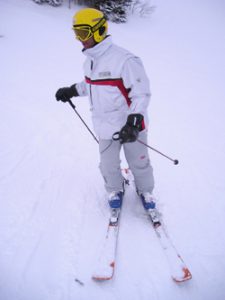
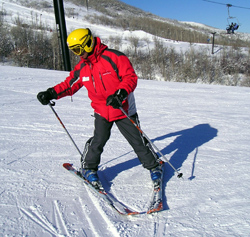
Remember, that all movements on skis are carried out by the legs, the upper body, at this stage, plays only a supporting role.
Now, I would like to discuss a simple but very important element – “the hockey stop”. In the correct performance of the hockey stop – the skis turn ninety degrees in relation to the direction of your initial movement and rotation of ankles occurs simultaneously. A rather widespread mistake takes place when the external leg brakes and the internal is then put to it, thus the stop is smudged, stretched out in time, losing both control and efficiency. It occurs, because the skier does not press ankles on the tongues of boots of the downhill leg strongly enough. Thus, the balance is displaced backward and, accordingly, too much weight falls on the uphill leg.
In order to correct this mistake, I would recommend practicing lateral side-slipping, various rotations of skis with simultaneous ankle rotations and making large-radius turns where movements of both legs occur simultaneously on very gentle slopes. A very useful exercise at the initial stages of skiing is to make large-radius turns on a wide gentle slope, achieving parallel skis without fail.
Now let’s address the skiers with experience who began skiing on long straight skis. The problem is that on long skis the range of the fore-aft movements during turn was much greater than on skis of modern geometry as the turn occurred due to a rotary movement of the ankles. On modern skis, rotary movement of the ankles is replaced by the bending of the shins and displacement of the center of gravity to the inside of the turn. The skis have changed, but if the techniques have remained old, new skis won’t change much for the skilled skier. I will not undertake to advise experienced skiers in the current article. I am positive that my recommendations would elicit negative response from the advocates of the godil and classical skis. Nonetheless, I would recommend taking a lesson with a competent instructor. There is nothing shameful in that. Many people who have been skiing for years come to me with the same request “Help me to re-trained, I am tired of fighting with these skis”. The best exercise in re-training is to make large-radius turns on a very gentle slope, in a wide stance so that the movement of both legs occurs simultaneously, while paying attention to how, due to the displacement of the center of gravity inside the turn, there is a bending of the ankles and the shins rest against tongues of boots. If there is no opportunity to find a competent instructor, please take advantage of this site. If you have any questions, please write us and we will always be happy to answer them.
I wish you all the best in the development of mountain-skiing techniques!


